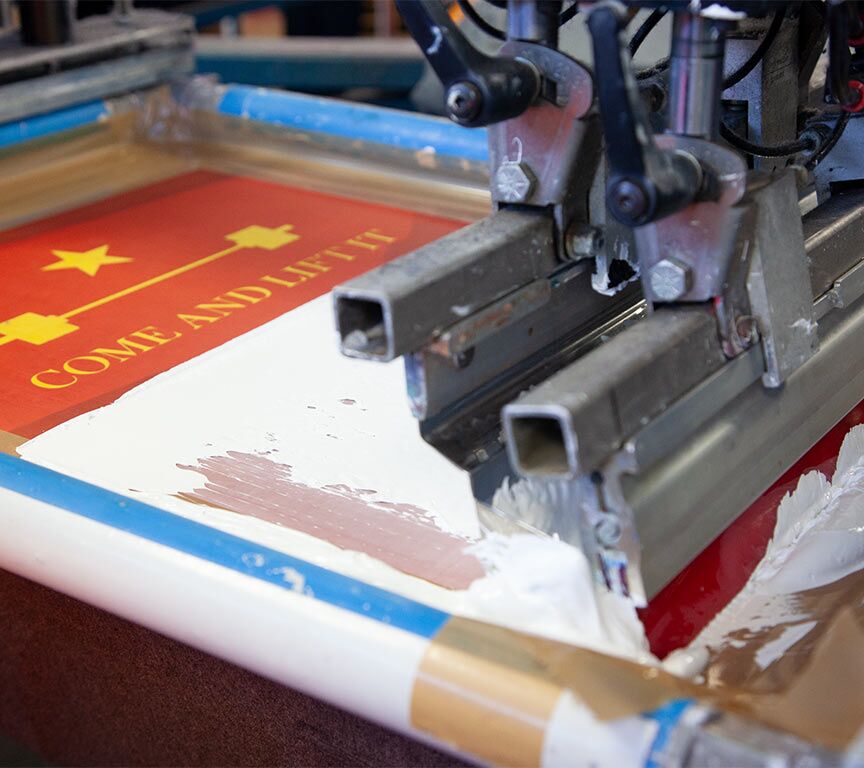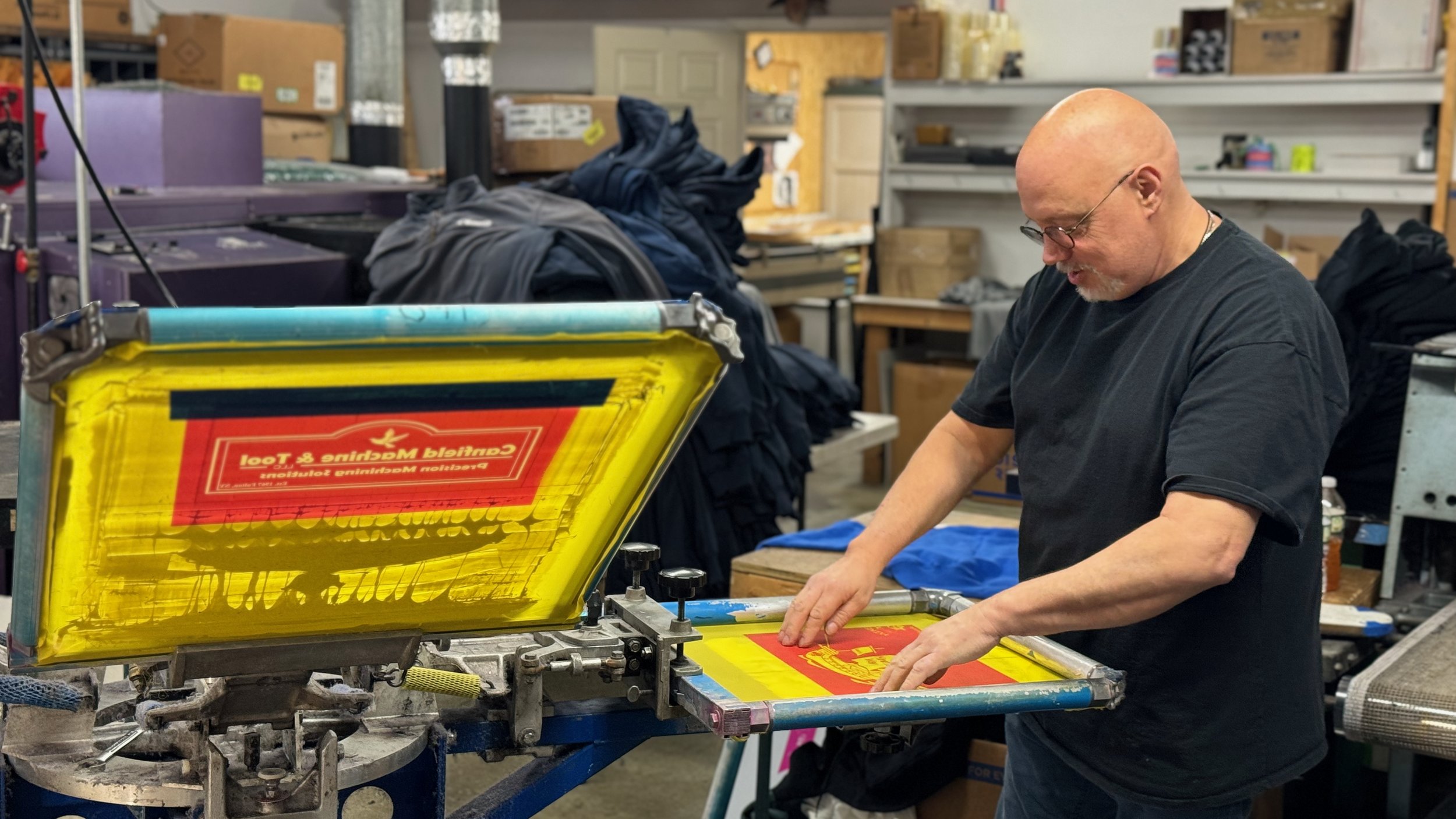Durable T-Shirt Printing for Everyday Wear
Wiki Article
Screen Printing Uncovered: Every Little Thing You Required to Learn About T-Shirt and Garment Printing Strategies
Screen printing is a remarkable method that incorporates art with method, supplying endless opportunities for imagination. Prepared to explore the vital aspects that make screen publishing an art type?
The Basics of Screen Printing: How It Functions
When you dive right into display printing, you'll find it's both a scientific research and an art. At its core, display printing includes producing a pattern, or screen, that permits ink to go through only in specific areas (screen printing kit). You start by choosing your style and preparing your display with a light-sensitive emulsion. As soon as you expose this emulsion to light, it hardens, leaving your style as a negative room.Placement the screen over the textile, then utilize a squeegee to press ink with the display onto the garment. Each action is vital, and mastering them will certainly elevate your display printing skills, changing basic garments right into unique, meaningful items.
Sorts Of Display Printing Methods
When you grasp the basics of display printing, it's time to check out the numerous methods that can elevate your styles. One preferred technique is standard screen printing, where ink is pressed with a stenciled display.Another choice is plastisol printing, recognized for its toughness and brilliant colors, making it a preferred for lots of brands. Experiment with halftone printing to create slope results and elaborate layouts.
Vital Devices for Screen Printing
To achieve magnificent lead to screen printing, having the best devices is basic. You'll require a tough screen printing structure, which holds the mesh that transfers your style onto the garment. Next, spend in premium squeegees; these are crucial for applying ink evenly throughout the screen. You'll likewise require a great exposure unit to develop your screens, as well as a washout cubicle for cleansing them after usage. A trustworthy heat resource, like a conveyor clothes dryer or warm press, is vital for healing your prints to guarantee long life. Don't fail to remember a correct work area, equipped with tables and storage space for your materials. Safety gear, such as masks and gloves, will certainly keep you secure from chemicals and inks. With the right devices, you'll be well on your way to generating professional-quality prints.Choosing the Right Inks and Materials
When choosing inks and products for display printing, you require to consider the kind of ink that works best for your task. Assume concerning fabric compatibility to assure your styles look excellent and last long. Explore environment-friendly ink options to make your printing process much more lasting.Sorts Of Screen Inks
Selecting the right screen ink is necessary for attaining vivid, sturdy prints that meet your project's needs. There are several sorts of display inks to analyze. Plastisol ink is preferred for its flexibility and convenience of usage, offering exceptional shade opacity on dark fabrics. Water-based ink, on the various other hand, supplies a softer feeling and is eco-friendly, making it ideal for those aiming to decrease their environmental effect. Release inks eliminate color from the material, leading to a soft, vintage look but need specific handling. Specialty inks, such as glow-in-the-dark or metallic, can add unique effects to your styles. Assess your project needs and choose the ink that lines up finest with your wanted result.
Material Compatibility Considerations
Understanding textile compatibility is essential for achieving high-grade screen prints, particularly because various products respond distinctively to different inks. Constantly test your inks on example material to ensure they adhere correctly and keep color stability. In addition, maintain in mind that textile weight and texture can affect the final outcome, so selecting the ideal ink and product combo is important for your task's success.Eco-Friendly Ink Options
Environment-friendly inks are becoming a preferred option for screen printers that intend to lessen their environmental effect while preserving quality. When picking inks, take into consideration water-based inks, which are less dangerous and much easier to tidy up compared to conventional solvents. These inks bond well with textiles, delivering lively outcomes without poisonous chemicals. You may additionally check out eco-solvent inks that make use of fewer unpredictable organic substances (VOCs), making them a much safer choice for both your health and the planet.Additionally, look for inks made from renewable energies, such as soy or vegetable-based alternatives. By choosing the best inks and materials, you'll not only develop sensational layouts however also add to a more sustainable printing process. Make the button, and your prints will certainly mirror your dedication to the atmosphere!
Preparing Your Style for Display Printing

File Format Needs
To ensure your style looks lively and sharp on textile, you'll require to pay very close attention to submit layout demands for display printing. Beginning with vector files like AI or EPS, as they can be scaled without shedding quality. If you utilize raster images, select high-resolution files, such as TIFF or PNG, preferably at 300 DPI. Stay clear of making use of JPEGs, as they can shed quality when resized. Make sure your layout has a clear background to stop unwanted white edges on your prints. Maintain color settings in mind; CMYK is typical for display printing, so transform your RGB develops appropriately - screen printing kit. By complying with these guidelines, you'll set your artwork up for a successful print.Color Separation Methods
Color splitting up is a crucial step in preparing your design for screen printing, and understanding it can significantly enhance your print quality. You'll require to damage your layout right into private colors, as each color calls for a separate display throughout printing. This accuracy not just ensures precise color representation however also streamlines the printing procedure.Resolution and Dimension
Accomplishing the most effective results screen printing kit in screen printing starts with ensuring your layout has the right resolution and dimension. Preferably, your art work ought to go to the very least 300 DPI (dots per inch) for sharp, clear prints. Your final product could look unprofessional and pixelated. if you use lower resolution.When it pertains to size, take into consideration the dimensions of your print area. Design your art work to match the final print size, ideally creating it in the actual measurements you'll be printing. This means, you'll prevent any kind of unforeseen scaling problems.
Always check your layout in both vector and raster styles. Vector graphics can be scaled without shedding quality, making them optimal for screen printing. Preparing properly will ensure your design looks remarkable on every garment!
Step-by-Step Screen Printing Refine
Screen printing is a dynamic procedure that enables you to develop dynamic designs on numerous surface areas. To begin, you'll need a screen, solution, and your picked ink. Prepare your display by cleaning it extensively. Next off, apply the emulsion equally and let it completely dry in a dark area. As soon as completely dry, subject your display to light with your style put on it, which will certainly solidify the emulsion where the light hits, creating a stencil - screen printing kit.Put ink onto the screen and use a squeegee to push the ink with the stencil onto the textile. Raise the display thoroughly and let the print dry. You've successfully screen printed your design.
Tips for Successful Display Printing Projects
While you're diving into your screen printing jobs, keep in mind that prep work is key to success. Begin by gathering all your products-- inks, squeegees, garments, and displays. A clean office aids prevent unwanted errors, so clean prior to you start.Next, confirm your artwork is high-resolution and properly sized for your garment. Examine your display for correct exposure and clean it completely to stay clear of smudges. When blending your inks, follow the maker's standards to attain the right uniformity.
Throughout printing, use even pressure with your squeegee for constant results. Do not hurry; take your time to verify each print satisfies your standards. After printing, let your garments completely dry completely prior to handling or packaging them.
Last but not least, constantly maintain a sample of your help future referral. By doing this, you can analyze your progress and enhance your methods with time. Delighted printing!

Often Asked Inquiries
For how long Does It Take to Establish up a Screen Printing Job?
Establishing a screen printing work typically takes about 30 minutes to an hour. You'll prepare the displays, mix inks, and adjust journalism. The time differs based upon intricacy and experience, so stay arranged!Can I Publish on Various Textile Types Making Use Of the Very Same Strategy?
Yes, you can publish on various fabric types utilizing the same technique, but you'll need to adjust your setups and inks. Some textiles absorb ink in a different way, so experimenting guarantees the most effective outcomes for each material.What Prevail Errors to Prevent in Screen Printing?
When screen printing, avoid common mistakes like making use of the incorrect ink, overlooking proper direct exposure times, or avoiding pre-press checks. Constantly check your configuration and preserve clean screens to ensure high quality results each time.Just How Can I Appropriately Tidy and Maintain My Screen Printing Devices?
To effectively clean and maintain your display printing equipment, you should routinely wash screens with appropriate solvents, examine squeegees for wear, and assure all devices are saved dust-free and completely dry. Uniformity protects against pricey repair work and boosts efficiency.Is Screen Printing Eco Pleasant Compared to Various Other Techniques?
Screen printing can be extra eco-friendly than other techniques, particularly if you utilize eco-conscious products and water-based inks. By picking lasting supplies and practices, you minimize waste and minimize your influence on the world.Display Printing Uncovered: Everything You Need to Know Regarding Tee and Garment Printing Strategies
At its core, screen printing includes creating a pattern, or display, that allows ink to pass with just in certain locations. Placement the display over the fabric, then use a squeegee to press ink with the screen onto the garment. One prominent approach is standard screen printing, where ink is pushed with a stenciled display.When picking inks and products for screen printing, you need to take into account the type of ink that works finest for your job.
Report this wiki page